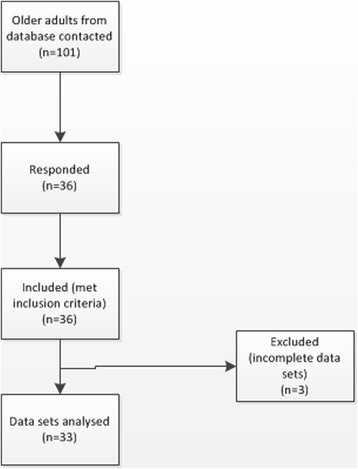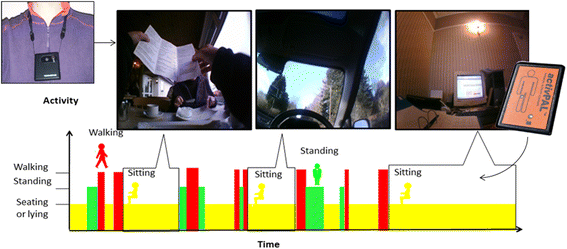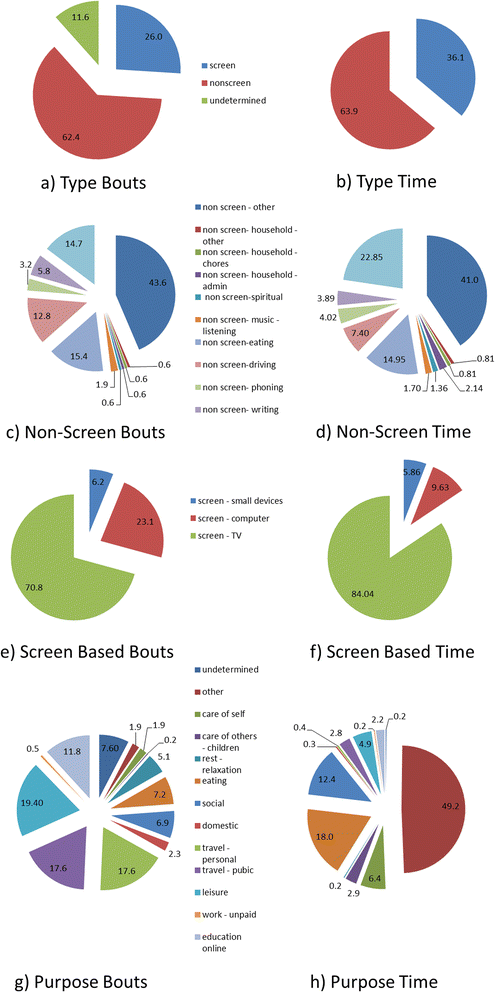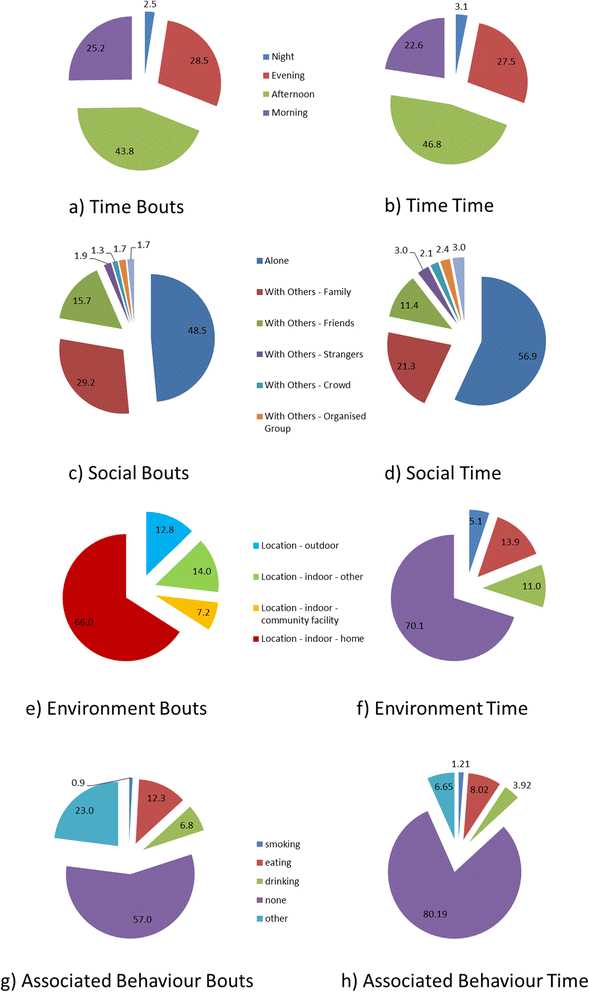Exploring the context of sedentary behaviour in older adults (what, where, why, when and with whom)
- PMID: 26865868
- PMCID: PMC4745148
- DOI: 10.1186/s11556-015-0146-7
Exploring the context of sedentary behaviour in older adults (what, where, why, when and with whom)
Abstract
Background: Older adults are the most sedentary segment of the population. Little information is available about the context of sedentary behaviour to inform guidelines and intervention. There is a dearth of information about when, where to intervene and which specific behaviours intervention should target. The aim of this exploratory study was to obtain objective information about what older adults do when sedentary, where and when they are sedentary and in what social context.
Methods: The study was a cross-sectional data collection. Older adults (Mean age = 73.25, SD ± 5.48, median = 72, IQR = 11) volunteers wore activPAL monitors and a Vicon Revue timelapse camera between 1 and 7 days. Periods of sedentary behaviour were identified using the activPAL and the context extracted from the pictures taken during these periods. Analysis of context was conducted using the Sedentary Behaviour International Taxonomy classification system.
Results: In total, 52 days from 36 participants were available for analysis. Participants spent 70.1 % of sedentary time at home, 56.9 % of sedentary time on their own and 46.8 % occurred in the afternoon. Seated social activities were infrequent (6.9 % of sedentary bouts) but prolonged (18 % of sedentary time). Participants appeared to frequently have vacant sitting time (41 % of non-screen sedentary time) and screen sitting was prevalent (36 % of total sedentary time).
Conclusions: This study provides valuable information to inform future interventions to reduce sedentary behaviour. Interventions should consider targeting the home environment and focus on the afternoon sitting time, though this needs confirmation in a larger study. Tackling social isolation may also be a target to reduce sedentary time.
Keywords: Accelerometer; Camera; Inclinometer; Lifelogging; SITONAUMY; Seniors; Sitting.
Figures




Similar articles
-
Descriptive study of sedentary behaviours in 35,444 French working adults: cross-sectional findings from the ACTI-Cités study.BMC Public Health. 2015 Apr 14;15:379. doi: 10.1186/s12889-015-1711-8. BMC Public Health. 2015. PMID: 25884816 Free PMC article.
-
The influence of dog ownership on objective measures of free-living physical activity and sedentary behaviour in community-dwelling older adults: a longitudinal case-controlled study.BMC Public Health. 2017 Jun 9;17(1):496. doi: 10.1186/s12889-017-4422-5. BMC Public Health. 2017. PMID: 28595596 Free PMC article.
-
The frequency of osteogenic activities and the pattern of intermittence between periods of physical activity and sedentary behaviour affects bone mineral content: the cross-sectional NHANES study.BMC Public Health. 2014 Jan 6;14:4. doi: 10.1186/1471-2458-14-4. BMC Public Health. 2014. PMID: 24393577 Free PMC article.
-
Interventions outside the workplace for reducing sedentary behaviour in adults under 60 years of age.Cochrane Database Syst Rev. 2020 Jul 17;7(7):CD012554. doi: 10.1002/14651858.CD012554.pub2. Cochrane Database Syst Rev. 2020. PMID: 32678471 Free PMC article.
-
Workplace interventions for reducing sitting at work.Cochrane Database Syst Rev. 2018 Dec 17;12(12):CD010912. doi: 10.1002/14651858.CD010912.pub5. Cochrane Database Syst Rev. 2018. PMID: 30556590 Free PMC article.
Cited by
-
Older adults' perspectives on physical activity and sedentary behaviour within their home using socio-ecological model.PLoS One. 2023 Nov 20;18(11):e0294715. doi: 10.1371/journal.pone.0294715. eCollection 2023. PLoS One. 2023. PMID: 37983222 Free PMC article.
-
Transition and factors associated with the level of physical activity combined with sedentary behavior of the elderly: A longitudinal study.Biomedica. 2020 Jun 15;40(2):322-335. doi: 10.7705/biomedica.5108. Biomedica. 2020. PMID: 32673460 Free PMC article.
-
Mapping sedentary behaviour (MAPS-B) in winter and spring using wearable sensors, indoor positioning systems, and diaries in older adults who are pre-frail and frail: A feasibility longitudinal study.PLoS One. 2024 May 16;19(5):e0290197. doi: 10.1371/journal.pone.0290197. eCollection 2024. PLoS One. 2024. PMID: 38753692 Free PMC article.
-
Is leisure sedentary time associated with mental health issues? Evidence from China Health and Nutrition Survey.Front Public Health. 2025 Feb 6;13:1517830. doi: 10.3389/fpubh.2025.1517830. eCollection 2025. Front Public Health. 2025. PMID: 39980927 Free PMC article.
-
Identifying daily activities of patient work for type 2 diabetes and co-morbidities: a deep learning and wearable camera approach.J Am Med Inform Assoc. 2022 Jul 12;29(8):1400-1408. doi: 10.1093/jamia/ocac071. J Am Med Inform Assoc. 2022. PMID: 35582885 Free PMC article.
References
LinkOut - more resources
Full Text Sources
Other Literature Sources

